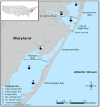Evaluation of the relationships between physico-chemical parameters and the abundance of Vibrio spp. in blue crabs (Callinectes sapidus) and seawater from the Maryland Coastal Bays
- PMID: 39479213
- PMCID: PMC11521862
- DOI: 10.3389/fmicb.2024.1459077
Evaluation of the relationships between physico-chemical parameters and the abundance of Vibrio spp. in blue crabs (Callinectes sapidus) and seawater from the Maryland Coastal Bays
Abstract
Introduction: Fluctuations in water quality characteristics influence the productivity of blue crabs (Callinectes sapidus), and the risk of human exposure to pathogenic Vibrio species. Thus, this study assessed the prevalence of total and pathogenic/clinical markers of Vibrio parahaemolyticus and Vibrio vulnificus in blue crabs and seawater from the Maryland Coastal Bays (MCBs) and the correlation between Vibrio levels and physicochemical parameters.
Methods: Three to five crabs and 1 L of seawater were collected monthly for 3 years (May 2018 to December 2020) from six sites within the MCBs. Hemolymph and crab tissue were extracted and pooled for each site. Extracted hemolymph, crab tissue, and seawater were analyzed for V. parahaemolyticus and V. vulnificus using the Most Probable Number (MPN) and real-time PCR methods. A one-way Analysis of Variance (ANOVA), correlations, and linear models were used to analyze the data. Akaike Information Criterion (AICc) was evaluated to determine the model that provides the best fit to the data relating to Vibrio concentrations and environmental factors.
Results: Results suggested that environmental factors could influence the growth of Vibrio spp. Both V. parahaemolyticus and V. vulnificus were more prevalent during the warmer months than colder months. Vibrio was more prevalent in crab samples compared to seawater. Vibrio vulnificus concentrations in seawater and hemolymph were positively correlated with temperature (p = 0.0143 seawater) and pH (p = 0.006 hemolymph). A negative correlation was observed between the concentration of V. vulnificus in whole crab (tissue) and dissolved oxygen level (p = 0.0256). The concentration of V. parahaemolyticus in seawater was positively correlated with temperature (p = 0.009) and negatively correlated with dissolved oxygen (p = 0.012).
Discussion: These results provide current information on the spatial and temporal distributions of Vibrio spp. in the MCBs that are useful for implementing more efficient processing and handling procedures of seafood products.
Keywords: Vibrio parahaemolyticus; Vibrio vulnificus; crabs; physicochemical parameters; predictive modeling.
Copyright © 2024 Smalls, Jacobs, Townsend, Chigbu and Parveen.
Conflict of interest statement
The authors declare that the research was conducted in the absence of any commercial or financial relationships that could be construed as a potential conflict of interest.
Figures




References
-
- Almuhaideb E., Chintapenta L. K., Abbott A., Parveen S., Gulnihal O. (2020). Assessment of Vibrio parahaemolyticus levels in oysters (Crassostrea virginica) and seawater in Delaware Bay in relation to environmental conditions and the prevalence of molecular markers to identify pathogenic Vibrio parahaemolyticus strains. PLoS One 15:e0242229. doi: 10.1371/journal.pone.0242229, PMID: - DOI - PMC - PubMed
-
- Apine E., Mani M. K., Rai P., Karunasagar I., Turner L. M. (2022). Future climate change conditions may compromise metabolic performance in juveniles of the mud crab Scylla serrata. J. Mar. Sci. Eng. 10:582. doi: 10.3390/jmse10050582 - DOI
-
- Baird D., Ulanowicz R. E. (1989). The seasonal dynamics of the Chesapeake Bay ecosystem. Ecol. Monogr. 59, 329–364. doi: 10.2307/1943071 - DOI
LinkOut - more resources
Full Text Sources
Miscellaneous

